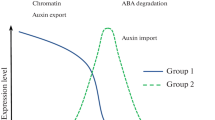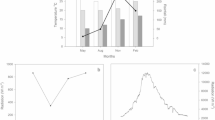Abstract
Traditionally the registration of seasonal changes in plant growth and development has been carried out phenologically, i.e., qualitatively using visual inspection. However, since the process of plant acclimatization to winter dormancy involves reversible biochemical and physiological changes at the level of cells, quantitative methods can be applied to determine the duration and the depth of winter dormancy in perennial plants. We used a method based on detecting thermally induced changes in the zero-level fluorescence (TICZF) on needles from four Siberian coniferous trees. Needles of Picea obovata Ledeb. and Abies sibirica Ledeb. recover from the state of winter dormancy much faster than those of Pinus sibirica Du Tour and Pinus sylvestris L. The photosynthetic apparatus in the needles of A. sibirica may be damaged during the spring period, characterized by unstable weather, when after several days of warm weather, the plants prematurely recover from winter dormancy. We conclude that under conditions of climate warming tree, species like A. sibirica may suffer from severe diebacks due to desiccation caused by premature break of winter dormancy.






Similar content being viewed by others
References
Alberdi M, Corcuera LJ (1991) Cold-acclimation in plants. Phytochemistry 30:3177–3184
Alberto FJ, Aitken SN, Alía R, González-Martínez SC, Hänninen H, Kremer A, Lefèvre F, Lenormand T, Yeaman S, Whetten R, Savolainen O (2013) Potential for evolutionary responses to climate change—evidence from tree populations. Glob Change Biol 19:1645–1661
Bonan GB (2008) Forests and climate change: forcings, feedbacks, and the climate benefits of forests. Science 320:1444–1449
Briantais J-M, Dacosta J, Goulas Y, Ducruet J-M, Moya I (1996) Heat stress induces in leaves an increase of the minimum level of chlorophyll fluorescence, Fo: a time-resolved analysis. Photosynth Res 48:189–196
Cannell MGR, Smith RI (1986) Climatic warming, spring budburst and frost damage on trees. J Appl Ecol 23:177–191
Cutler S, Bonetta D (2008) Plant hormones: methods and protocols Series. Methods Mol Biol 495:39–51
Downton WJS, Berry JA (1982) Chlorophyll fluorescence at high temperature. Biochim Biophys Acta 679:474–478
Duan B, Yang Y, Lu Y, Li C, Korpelainen H, Berninger F (2007) Interactions between water deficit, ABA, and provenances in Picea asperata. J Exp Bot 58:302–305
Feurtado JA, Ambrose SJ, Cutler AJ, Ross ARS, Abrams SR, Kermode AR (2004) Dormancy termination of western white pine (Pinus monticola DOUGL. Ex D. Don) seeds is associated with changes in abscisic acid metabolism. Planta 218:630–639
Gaevskiy NA, Sorokina GA et al. (1987) Russian Patent: AC №1358843(August 15, 1987). A method for determining the depth of dormancy of woody plants. (in Russian)
Gaevskiy NA, Ladygin VG, Gol’d VM (1989) New data on the nature of high-temperature rise in the chlorophyll fluorescence. Physiologiya rasteniy 36:272 (in Russian)
Gaevskiy NA, Sorokina GA, Gol’d VM, Mirolyubskaya IV (1991) Seasonal changes of the photosynthetic apparatus of woody and shrub plants. Physiol rasteniy 38:685–692 (in Russian)
Gaevsky N A (2002) Determination of the season-acclimation of photosynthetic apparatus by heat-induced changes in chlorophyll fluorescence. In: Dumroese, R. K.; Riley, L. E.; Landis, T. D., technical coordinators. National proceedings: forest and conservation nursery associations-1999, 2000, and 2001. Proceedings RMRS-P-24. Ogden, UT: U.S. Department of Agriculture Forest Service, Rocky Mountain Research Station
GrigorievYS Pakharkova NV (2001) Effect of industrial environmental pollution on winter dormancy in Scots pine. Russian Journal of Ecology 32:437–439
Hänninen H (1990) Modeling dormancy release in trees from cool and temperate regions. In: Dixon RK, Meldahl RS, Ruark GA, Warren WG (eds) Process modeling of forest growth responses to environmental stress. Timber Press, Portland, pp 159–165
Hänninen H (1991) Does climatic warming increase the risk of frost damage in northern trees? Plant, Cell Environ 14:449–454
Hänninen H (1995) Effects of climatic change on trees from cool and temperate regions: an ecophysiological approach to modeling of budburst phenology. Can J Bot 73:183–199
Hänninen H (2006) Climate warming and the risk of frost damage to boreal forest trees: identification of critical ecophysiological traits. Tree Physiol 26:889–898
Harrington CA, Gould PJ, StClair JB (2010) Modeling the effects of winter environment on dormancy release of Douglas-fir. For Ecol Manage 259:798–808
Heide OM (2003) High autumn temperature delays spring budburst in boreal trees, counterbalancing the effect of climate warming. Tree Physiol 21:931–936
Ilík P, Kouril R, Fiala J, Naus J, Vácha F (2000) Spectral characterization of chlorophyll fluorescence in barley leaves during linear heating. Analysis of high-temperature fluorescence rise around 60 degrees C. J Photochem Photobiol B: Biol 59:103–114
Ilík P, Nauš J, Špunda V, Čajánek M, Cikánek D, Pospíšil P (1997) High temperature chlorophyll fluorescence rise within 61–67 °C. Spectroscopic study with intermittent light grown barley leaves. J Photochem Photobiol B 39:243–248
IPCC (2013) Climate change 2013: The physical science basis. contribution of working group I to the fifth assessment report of the intergovernmental panel on climate change. In: Stocker TF, Qin D, Plattner GK, Tignor M, Allen SK, Boschung J, Nauels A, Xia Y, Bex V, Midgley PM (eds.) Cambridge University Press, Cambridge
Kellomäki S, Hänninen H, Kolström M (1995) Computations on frost damage to Scots pine under climatic warming in boreal conditions. Ecol Appl 5:42–52
Lichtenthaler HK (1987) Chloropyll and Carotinoides: pigments of Photosynthetic Biomembranes. Methods Enzymol 148:331–382
Lipova L, Krchnak P, Komenda J, Ilik P (2010) Heat-induced disassembly and degradation of chlorophyll-containing protein complexes in vivo. Biochim Biophys Acta 1797:63–70
Maslova TG, Mamushkina NS, Sherstneva OA, Bubolo LS, Zubkova EK (2009) Structural-functional changes of photosynthetic apparatus of winter-vegetating conifers during various seasons. Physiologiya rasteniy 56:672–681 (in Russian)
Menzel A, Fabian P (1999) Growing season extended in Europe. Nature 397:659
Öguist G, Huner NPA (2003) Photosynthesis of overwintering evergreen plants. Annu Rev Plant Biol 54:329–355
Ohse B, Jansen F, Wilmking M (2012) Do limiting factors at Alaskan treelines shift with climatic regimes? Environmental Research Letters 7:015505. doi:10.1088/1748-9326/7/1/015505
Ovchinnikova TM, Fomina VA, Dolzhkovaya NP, Andreeva EB, Sukhovolskiy VG (2010) Modeling of phenological dynamics. Analysis of correlations of timings of seasonal phenomena of woody plants with climatic factors. Trudy gosudarstvennogo zapovednika “Stolby” Krasnoyarsk 19:76–89 (in Russian)
Pakharkova NV, Kalyakina OP, Shubin AA, Grigoriev YS (2009) Fluorescent diagnostics of winter dormancy of conifers in urban ecosystems with different level of environmental pollution. J Sib Fed Univ (Chem) 4:359–367 (in Russian)
Pakharkova NV, Kuzmina NA, Kuzmin SR, Efremov AA (2014) Morphophysiological traits of needles in different climatypes of Scots Pine in provenance trials. Contemp Probl Ecol 7:84–89. doi:10.1134/S1995425514010107
Pakharkova NV, Sorokina GA, Shubin AA (2012) The influence of pollution of the environment on winter dormancy of woody plants. Teoreticheskaya I Prikladnaya Ekologiya 2:20–25 (in Russian)
Perry TO (1971) Dormancy of trees in winter. Science 171:29–36
Petrov KA, Sofronova VE, Bubyakina VV, Perk AA, Tatarinova TD, Ponomarev AG, Chepalov VA, Okhlopkova ZM, Vasilieva IV, Maximov TH (2011) Woody plants of Yakutia and low-temperature stress. Physiol rasteniy 58:866–874 (in Russian)
Saxe H, Cannell MGR, Johnsen Ø, Ryan MG, Vourlitis G (2001) Tree and forest functioning in response to global warming. New Phytol 149:369–400
Schaedle M, Foot KC (1971) Seasonal changes in the photosynthetic capacity of bark. For Sci 17:308–313
Schreiber U, Berry JA (1977) Heat induced changes of chlorophyll fluorescence in intact leaves correlated with damage of the photosynthetic apparatus. Planta 136:233–238
Schreiber U, Armond PA (1978) Heat-induced changes of chlorophyll fluorescence in isolated chloroplasts and related heat-damage at the pigment level. Biochim Biophys Acta 502:138–151
Senser M, Beck E (1977) On the mechanisms of frost injury and frost hardening of spruce chloroplasts. Planta 137:195–201
Senser M, Schötz F, Beck E (1975) Seasonal changes in structure and function of spruce chloroplasts. Planta 126:1–10
Shultz GE (1981) General phenology. Nauka (in Russian)
Wilmking M, Juday GP, Barber VA, Zald HSJ (2004) Recent climate warming forces contrasting growth responses of white spruce at treeline in Alaska through temperature thresholds. Glob Change Biol 10:1724–1736
Acknowledgements
We are grateful for the critical comments provided during the review process of this manuscript. The publication is supported by the Russian Foundation for Basic Research and Krasnoyarsk Region Science and Technology Support Fund (Grant No. 15-44-04132).
Author information
Authors and Affiliations
Corresponding author
Additional information
An erratum to this article is available at http://dx.doi.org/10.1007/s40415-017-0370-7.
Rights and permissions
About this article
Cite this article
Pakharkova, N.V., Heilmeier, H., Gette, I.G. et al. Quantitative characteristics of the phases of winter dormancy of conifer species at a site in Central Siberia. Braz. J. Bot 39, 1005–1014 (2016). https://doi.org/10.1007/s40415-016-0298-3
Received:
Accepted:
Published:
Issue Date:
DOI: https://doi.org/10.1007/s40415-016-0298-3




